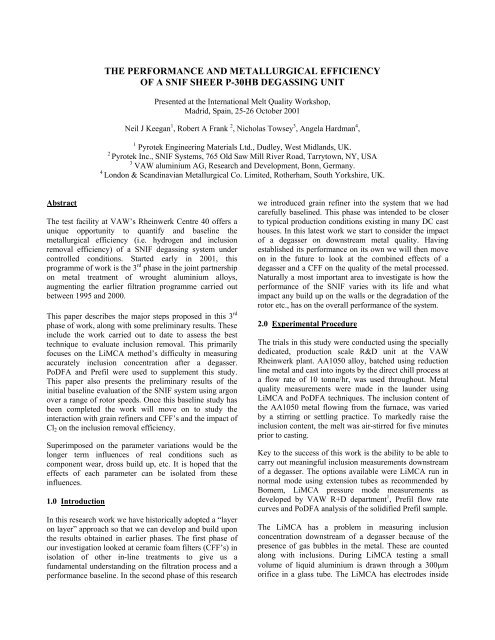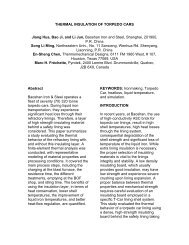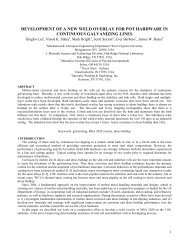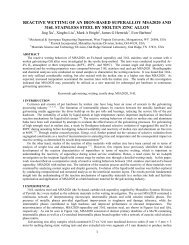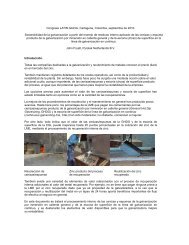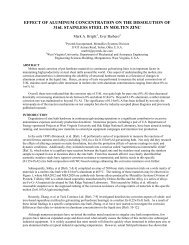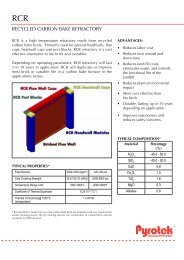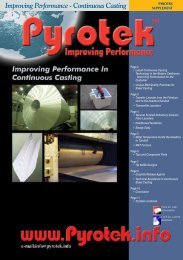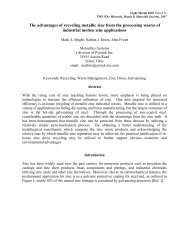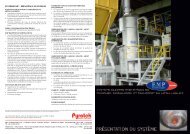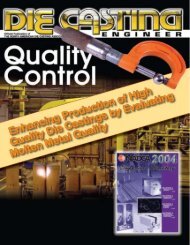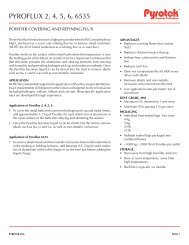the performance and metallurgical efficiency of a snif sheer ... - Pyrotek
the performance and metallurgical efficiency of a snif sheer ... - Pyrotek
the performance and metallurgical efficiency of a snif sheer ... - Pyrotek
Create successful ePaper yourself
Turn your PDF publications into a flip-book with our unique Google optimized e-Paper software.
Abstract<br />
THE PERFORMANCE AND METALLURGICAL EFFICIENCY<br />
OF A SNIF SHEER P-30HB DEGASSING UNIT<br />
Presented at <strong>the</strong> International Melt Quality Workshop,<br />
Madrid, Spain, 25-26 October 2001<br />
Neil J Keegan 1 , Robert A Frank 2 , Nicholas Towsey 3 , Angela Hardman 4 ,<br />
1 <strong>Pyrotek</strong> Engineering Materials Ltd., Dudley, West Midl<strong>and</strong>s, UK.<br />
2 <strong>Pyrotek</strong> Inc., SNIF Systems, 765 Old Saw Mill River Road, Tarrytown, NY, USA<br />
3 VAW aluminium AG, Research <strong>and</strong> Development, Bonn, Germany.<br />
4 London & Sc<strong>and</strong>inavian Metallurgical Co. Limited, Ro<strong>the</strong>rham, South Yorkshire, UK.<br />
The test facility at VAW’s Rheinwerk Centre 40 <strong>of</strong>fers a<br />
unique opportunity to quantify <strong>and</strong> baseline <strong>the</strong><br />
<strong>metallurgical</strong> <strong>efficiency</strong> (i.e. hydrogen <strong>and</strong> inclusion<br />
removal <strong>efficiency</strong>) <strong>of</strong> a SNIF degassing system under<br />
controlled conditions. Started early in 2001, this<br />
programme <strong>of</strong> work is <strong>the</strong> 3 rd phase in <strong>the</strong> joint partnership<br />
on metal treatment <strong>of</strong> wrought aluminium alloys,<br />
augmenting <strong>the</strong> earlier filtration programme carried out<br />
between 1995 <strong>and</strong> 2000.<br />
This paper describes <strong>the</strong> major steps proposed in this 3 rd<br />
phase <strong>of</strong> work, along with some preliminary results. These<br />
include <strong>the</strong> work carried out to date to assess <strong>the</strong> best<br />
technique to evaluate inclusion removal. This primarily<br />
focuses on <strong>the</strong> LiMCA method’s difficulty in measuring<br />
accurately inclusion concentration after a degasser.<br />
PoDFA <strong>and</strong> Prefil were used to supplement this study.<br />
This paper also presents <strong>the</strong> preliminary results <strong>of</strong> <strong>the</strong><br />
initial baseline evaluation <strong>of</strong> <strong>the</strong> SNIF system using argon<br />
over a range <strong>of</strong> rotor speeds. Once this baseline study has<br />
been completed <strong>the</strong> work will move on to study <strong>the</strong><br />
interaction with grain refiners <strong>and</strong> CFF’s <strong>and</strong> <strong>the</strong> impact <strong>of</strong><br />
Cl2 on <strong>the</strong> inclusion removal <strong>efficiency</strong>.<br />
Superimposed on <strong>the</strong> parameter variations would be <strong>the</strong><br />
longer term influences <strong>of</strong> real conditions such as<br />
component wear, dross build up, etc. It is hoped that <strong>the</strong><br />
effects <strong>of</strong> each parameter can be isolated from <strong>the</strong>se<br />
influences.<br />
1.0 Introduction<br />
In this research work we have historically adopted a “layer<br />
on layer” approach so that we can develop <strong>and</strong> build upon<br />
<strong>the</strong> results obtained in earlier phases. The first phase <strong>of</strong><br />
our investigation looked at ceramic foam filters (CFF’s) in<br />
isolation <strong>of</strong> o<strong>the</strong>r in-line treatments to give us a<br />
fundamental underst<strong>and</strong>ing on <strong>the</strong> filtration process <strong>and</strong> a<br />
<strong>performance</strong> baseline. In <strong>the</strong> second phase <strong>of</strong> this research<br />
we introduced grain refiner into <strong>the</strong> system that we had<br />
carefully baselined. This phase was intended to be closer<br />
to typical production conditions existing in many DC cast<br />
houses. In this latest work we start to consider <strong>the</strong> impact<br />
<strong>of</strong> a degasser on downstream metal quality. Having<br />
established its <strong>performance</strong> on its own we will <strong>the</strong>n move<br />
on in <strong>the</strong> future to look at <strong>the</strong> combined effects <strong>of</strong> a<br />
degasser <strong>and</strong> a CFF on <strong>the</strong> quality <strong>of</strong> <strong>the</strong> metal processed.<br />
Naturally a most important area to investigate is how <strong>the</strong><br />
<strong>performance</strong> <strong>of</strong> <strong>the</strong> SNIF varies with its life <strong>and</strong> what<br />
impact any build up on <strong>the</strong> walls or <strong>the</strong> degradation <strong>of</strong> <strong>the</strong><br />
rotor etc., has on <strong>the</strong> overall <strong>performance</strong> <strong>of</strong> <strong>the</strong> system.<br />
2.0 Experimental Procedure<br />
The trials in this study were conducted using <strong>the</strong> specially<br />
dedicated, production scale R&D unit at <strong>the</strong> VAW<br />
Rheinwerk plant. AA1050 alloy, batched using reduction<br />
line metal <strong>and</strong> cast into ingots by <strong>the</strong> direct chill process at<br />
a flow rate <strong>of</strong> 10 tonne/hr, was used throughout. Metal<br />
quality measurements were made in <strong>the</strong> launder using<br />
LiMCA <strong>and</strong> PoDFA techniques. The inclusion content <strong>of</strong><br />
<strong>the</strong> AA1050 metal flowing from <strong>the</strong> furnace, was varied<br />
by a stirring or settling practice. To markedly raise <strong>the</strong><br />
inclusion content, <strong>the</strong> melt was air-stirred for five minutes<br />
prior to casting.<br />
Key to <strong>the</strong> success <strong>of</strong> this work is <strong>the</strong> ability to be able to<br />
carry out meaningful inclusion measurements downstream<br />
<strong>of</strong> a degasser. The options available were LiMCA run in<br />
normal mode using extension tubes as recommended by<br />
Bomem, LiMCA pressure mode measurements as<br />
developed by VAW R+D department 1 , Prefil flow rate<br />
curves <strong>and</strong> PoDFA analysis <strong>of</strong> <strong>the</strong> solidified Prefil sample.<br />
The LiMCA has a problem in measuring inclusion<br />
concentration downstream <strong>of</strong> a degasser because <strong>of</strong> <strong>the</strong><br />
presence <strong>of</strong> gas bubbles in <strong>the</strong> metal. These are counted<br />
along with inclusions. During LiMCA testing a small<br />
volume <strong>of</strong> liquid aluminium is drawn through a 300µm<br />
orifice in a glass tube. The LiMCA has electrodes inside
<strong>and</strong> outside <strong>the</strong> tube. The electrical conductivity <strong>of</strong> <strong>the</strong><br />
metal is changed as non-conducting inclusion particles are<br />
drawn into <strong>the</strong> tube along with <strong>the</strong> liquid metal. The<br />
particles can, <strong>the</strong>refore, be counted <strong>and</strong> <strong>the</strong>ir size<br />
estimated in a way similar to that <strong>of</strong> a Coulter counter.<br />
The normal way that <strong>the</strong>se measurements are done is on<br />
<strong>the</strong> up cycle known as <strong>the</strong> normal or vacuum mode. In<br />
order to try to discount <strong>the</strong> effect <strong>of</strong> gas bubbles a method<br />
was developed by VAW R+D 1 whereby <strong>the</strong> <strong>the</strong> counting is<br />
done on <strong>the</strong> down cycle as <strong>the</strong> metal is ejected through this<br />
orifice. This is referred to as <strong>the</strong> pressure mode.<br />
Recently Comalco 2 reported some work which looked at<br />
<strong>the</strong> pressure method <strong>and</strong> <strong>the</strong> use <strong>of</strong> extension tubes<br />
independently <strong>of</strong> our testing <strong>and</strong> whilst <strong>the</strong>y felt it had<br />
potential <strong>the</strong>y raised concerns that inclusion losses were<br />
occurring during <strong>the</strong>se measurements.<br />
In our work our first aim was to verify that <strong>the</strong> use <strong>of</strong> 2<br />
<strong>and</strong> 3 LiMCA’s at different locations with normal mode <strong>of</strong><br />
operation <strong>and</strong> extension tubes gave us repeatable results.<br />
We <strong>the</strong>n wanted to establish what errors we had by using<br />
<strong>the</strong> pressure mode <strong>and</strong> extension tubes. To do this we<br />
carried out trials running <strong>the</strong> LiMCA’s side by side in our<br />
casting line without gas bubbles in <strong>the</strong> system – i.e. before<br />
<strong>the</strong> installation <strong>of</strong> <strong>the</strong> degasser. We <strong>the</strong>n carried out<br />
similar measurements downstream <strong>of</strong> a SNIF degasser on<br />
a production line in <strong>the</strong> Rheinwerk plant to make<br />
comparisons <strong>of</strong> <strong>the</strong> results in <strong>the</strong> presence <strong>of</strong> bubbles. As a<br />
result <strong>of</strong> this we felt that we were in a position to progress<br />
on to install <strong>the</strong> SNIF P30 on <strong>the</strong> experimental casting<br />
line. We also concluded that N20 <strong>and</strong> possibly higher<br />
would now be used as our baseline as N15 was considered<br />
too sensitive to gas bubbles.<br />
Figure 1 shows <strong>the</strong> SNIF SHEER P30-HB as installed on<br />
<strong>the</strong> experimental casting line during its commissioning<br />
cast. This is a sealed single rotor SNIF system. Figure 2<br />
shows a photograph <strong>of</strong> <strong>the</strong> experimental casting unit <strong>and</strong><br />
launder runs taken from <strong>the</strong> ro<strong>of</strong> <strong>of</strong> <strong>the</strong> SNIF P30. Metal<br />
enters <strong>the</strong> SNIF from <strong>the</strong> 20 tonne cylindrical casting<br />
furnace on <strong>the</strong> left before exiting via <strong>the</strong> launder on <strong>the</strong><br />
bottom right h<strong>and</strong> side <strong>of</strong> <strong>the</strong> photograph. This launder<br />
continues fully 9m before reaching <strong>the</strong> casting launder.<br />
The experimental casting line was set up like this in order<br />
to try to limit <strong>the</strong> influence <strong>of</strong> gas bubbles on our LiMCA<br />
measurements. Two LiMCA’s can also be seen in this<br />
photograph as used during <strong>the</strong> experimental programme.<br />
One is just in front <strong>of</strong> <strong>the</strong> SNIF P30 on <strong>the</strong> bottom left<br />
h<strong>and</strong> side <strong>and</strong> <strong>the</strong> second is at <strong>the</strong> top centre <strong>of</strong> <strong>the</strong><br />
photograph showing measurements being conducted<br />
downstream <strong>of</strong> <strong>the</strong> SNIF unit just ahead <strong>of</strong> <strong>the</strong> casting<br />
launder.<br />
Figure 1: SNIF SHEER P30-HB on Rheinwerk casting line.<br />
Figure 2: Experimental Casting Pit Layout.<br />
3.0 Results <strong>and</strong> Discussion<br />
3.1 LiMCA testing using normal <strong>and</strong> extension tubes in<br />
normal <strong>and</strong> pressure mode without argon gas bubbles in<br />
<strong>the</strong> system.<br />
Figure 3 shows <strong>the</strong> LiMCA traces for 3 LiMCA’s ran<br />
side by side with extension tubes on our casting line<br />
without bubbles i.e. without a degasser in <strong>the</strong> line. We can<br />
see that <strong>the</strong> three units are quite repeatable over <strong>the</strong> cast as<br />
a whole. There is a higher degree <strong>of</strong> scatter which is quite<br />
normal when running with extension tubes. The areas <strong>of</strong><br />
<strong>the</strong> traces outlined with <strong>the</strong> red circles show where one <strong>of</strong><br />
<strong>the</strong> units was run in pressure mode. The first <strong>and</strong> last is<br />
where <strong>the</strong> LiMCA with <strong>the</strong> black line is run in pressure<br />
mode. In <strong>the</strong> first instance <strong>the</strong> pressure mode seems to<br />
have made very little difference. In <strong>the</strong> latter case as with<br />
<strong>the</strong> LiMCA shown by <strong>the</strong> pink line <strong>the</strong>re may be an<br />
indication that <strong>the</strong> readings are slightly lower in this mode<br />
than in normal mode. In contrast, however, o<strong>the</strong>r casts<br />
showed <strong>the</strong> pressure mode sometimes gave higher results
than vacuum. This was probably, given general<br />
experiences with extension tubes, due to <strong>the</strong> scatter that<br />
occurs whilst running <strong>the</strong>se tubes.<br />
Figure 3: 3 LiMCA’s run in normal mode with extension<br />
tubes - no argon gas bubbles – i.e. without degasser.<br />
Figure 4 shows a trial where all three units were run<br />
initially in normal mode with normal tubes for <strong>the</strong> without<br />
bubbles case i.e. without degasser. The repeatability is<br />
again very good. After 35 minutes an extension tube was<br />
put on <strong>the</strong> second LiMCA, <strong>the</strong> one represented by <strong>the</strong> blue<br />
line. It can be seen that this has led to a lower level <strong>of</strong><br />
inclusions being counted.<br />
Figure 4: 3 LiMCA units run in normal mode, 2 with<br />
normal tubes, 1 with extension tube – no argon gas bubbles.<br />
Figure 5 shows clearly <strong>the</strong> <strong>of</strong>fset that occurs when using<br />
extension tubes compared with normal tubes. This is again<br />
for <strong>the</strong> without bubbles case. The green line is our<br />
reference line <strong>and</strong> shows <strong>the</strong> trace for normal mode with<br />
normal tubes. The blue <strong>and</strong> pink lines <strong>of</strong> <strong>the</strong> second <strong>and</strong><br />
third LiMCA are run using extension tubes. It can be seen<br />
that <strong>the</strong>re is a clear <strong>of</strong>fset between <strong>the</strong> counts obtained<br />
with extension tubes as compared with those gained using<br />
<strong>the</strong> normal tube. After approximately 25 minutes <strong>the</strong><br />
second LiMCA shown with <strong>the</strong> blue line was run in<br />
pressure mode. In this case, admittedly at low inclusion<br />
levels, <strong>the</strong> pink <strong>and</strong> blue lines show little difference<br />
between <strong>the</strong> pressure <strong>and</strong> normal mode.<br />
Figure 5: 3 LiMCA units, 1run in normal mode with a<br />
normal tube, 2 with extension tubes – no argon gas bubbles.<br />
3.2 LiMCA testing using normal <strong>and</strong> extension tubes in<br />
normal <strong>and</strong> pressure mode with argon gas bubbles in <strong>the</strong><br />
system.<br />
Having carried out some validation trials using <strong>the</strong><br />
LiMCA without bubbles, we <strong>the</strong>n went on to evaluate<br />
some production metal downstream <strong>of</strong> a SNIF degassing<br />
unit which represented <strong>the</strong> ‘with argon bubbles’ case.<br />
Figure 6: LiMCA results before <strong>and</strong> after a SNIF R140 on<br />
Rheinewerk production unit, with extension tubes.<br />
Figure 6 shows a typical trial result. The pink line is from<br />
<strong>the</strong> LiMCA downstream <strong>and</strong> close to <strong>the</strong> degassing unit.<br />
It can be seen that <strong>the</strong> first measurements made in normal<br />
mode using extension tubes show that <strong>the</strong> LiMCA counts<br />
are much higher after <strong>the</strong> degasser than before. This is
elieved to be as a result <strong>of</strong> counting bubbles. When we<br />
switched <strong>the</strong> LiMCA to pressure mode we can see that for<br />
<strong>the</strong>se conditions we appear to be eliminating most <strong>of</strong> <strong>the</strong><br />
gas bubbles from our counts. We do not know <strong>the</strong> loss <strong>of</strong><br />
inclusions due to <strong>the</strong> pressure mode <strong>and</strong> extension tube<br />
combined. When we switched back to normal mode <strong>the</strong><br />
line immediately returned to a level similar to that<br />
detected before. Going back to pressure mode again gave<br />
us a value similar or slightly lower than that <strong>of</strong> <strong>the</strong><br />
incoming metal counts.<br />
Figure 7: LiMCA results before <strong>and</strong> after <strong>the</strong> SNIF<br />
SHEER P30-HB with extension tubes in pressure <strong>and</strong><br />
vacuum mode.<br />
Figure 7 shows one <strong>of</strong> <strong>the</strong> first LiMCA trials run with <strong>the</strong><br />
SNIF P30 for <strong>the</strong> “with gas bubbles” scenario. In this trial<br />
<strong>the</strong> SNIF was set to run at 500 rpm <strong>and</strong> with 3Nm 3 /hr<br />
argon. We were now varying <strong>the</strong> SNIF parameters <strong>and</strong><br />
along with <strong>the</strong> PoDFA trying to establish <strong>the</strong> measurement<br />
errors for each setting due to <strong>the</strong> different inclusion <strong>and</strong><br />
bubble losses. It must be assumed that <strong>the</strong> inclusion <strong>and</strong><br />
gas bubble size distribution is also changing accordingly.<br />
The before LiMCA curve is in pink <strong>and</strong> it can be seen that<br />
<strong>the</strong> incoming metal was very clean. This was verified by<br />
<strong>the</strong> PoDFA counts taken to supplement <strong>the</strong> LiMCA<br />
measurements. During this trial consecutive points were<br />
taken in normal <strong>and</strong> pressure mode using extension tubes.<br />
The pressure mode has lead to lower counts than was <strong>the</strong><br />
case for <strong>the</strong> normal mode but <strong>the</strong> downstream LiMCA<br />
values can be seen to be still higher than those <strong>of</strong> <strong>the</strong><br />
upstream LiMCA . The PoDFA showed o<strong>the</strong>rwise being<br />
very clean at less than 0.01mm 2 /kg. It appeared, <strong>the</strong>refore,<br />
that despite having <strong>the</strong> LiMCA over 9m away we were<br />
still counting very small gas bubbles after <strong>the</strong> degasser.<br />
The marked reduction in counts detected using <strong>the</strong><br />
pressure mode as opposed to <strong>the</strong> normal mode is shown<br />
more clearly in Figure 8, <strong>the</strong> histogram for <strong>the</strong> previous<br />
trial.<br />
Figure 8: LiMCA histogram results for after <strong>the</strong> SNIF<br />
SHEER P30-HB with extension tubes in pressure <strong>and</strong><br />
vacuum mode.<br />
The SNIF P30 operating parameters were <strong>the</strong>n changed to<br />
check our measurement technique over a wider range <strong>of</strong><br />
settings. In Figure 9 we see that for <strong>the</strong>se parameters <strong>the</strong><br />
LiMCA’s perform differently to before. The incoming<br />
metal is dirtier than for <strong>the</strong> previous trial <strong>and</strong> is shown<br />
with <strong>the</strong> blue line. This was again found to agree with <strong>the</strong><br />
subsequent PoDFA measurements. The downstream<br />
LiMCA SNIF values are again shown in pink. This time<br />
when we switch to pressure mode as represented by <strong>the</strong><br />
red points, we seem to be excluding most <strong>of</strong> <strong>the</strong> gas<br />
bubbles generated for <strong>the</strong>se SNIF settings. The PoDFA’s<br />
were again as clean as for <strong>the</strong> last example which<br />
supported this conclusion.<br />
Figure 9: LiMCA results for before <strong>and</strong> after <strong>the</strong> SNIF<br />
SHEER P30-HB operating at 400rpm with 2Nm 3 /hr argon<br />
run with extension tubes in pressure <strong>and</strong> vacuum mode
Figure 10: Typical PoDFA fields for before <strong>and</strong> after <strong>the</strong><br />
SNIF SHEER P30-HB on <strong>the</strong> experimental casting line for<br />
cast 020401-2<br />
Figure 10 shows some typical fields from <strong>the</strong><br />
<strong>metallurgical</strong> evaluation <strong>of</strong> <strong>the</strong> Prefil samples. The left<br />
h<strong>and</strong> side shows <strong>the</strong> before SNIF sample with a large<br />
aluminium carbide layer adjacent to <strong>the</strong> top <strong>of</strong> <strong>the</strong> sample.<br />
This has a PoDFA count <strong>of</strong> 0.6 mm2/kg. The after SNIF<br />
sample can be seen to be very much cleaner with much<br />
less <strong>of</strong> a layer being formed in <strong>the</strong> sample. This had a<br />
PoDFA count <strong>of</strong> 0.2mm2/kg.<br />
Figure 11: PoDFA total inclusion contents for <strong>the</strong> SNIF<br />
SHEER P30-HB on <strong>the</strong> experimental casting line.<br />
Figure 11 shows <strong>the</strong> results <strong>of</strong> <strong>the</strong> PoDFA counts for <strong>the</strong><br />
before <strong>and</strong> after SNIF P30 samples taken during our trials.<br />
It can be seen that for <strong>the</strong> clean SNIF unit a good inclusion<br />
removal is consistently being obtained. This shows that<br />
<strong>the</strong> LiMCA is indeed measuring bubbles after <strong>the</strong> SNIF<br />
ra<strong>the</strong>r than inclusions.<br />
It appeared, <strong>the</strong>refore, that we still needed to adapt our<br />
LiMCA measurement technique if we were to be able to<br />
use <strong>the</strong>m successfully downstream <strong>of</strong> a degassing unit.<br />
With this in mind we have come up with a special<br />
approach. We have called this <strong>the</strong> “background method”.<br />
The logic is that we collect data upstream <strong>and</strong> downstream<br />
<strong>of</strong> <strong>the</strong> degasser for a period until <strong>the</strong> readings are<br />
considered to be stable. Figure 12 shows a trial where we<br />
tested this new approach. The downstream SNIF values<br />
are again in pink <strong>and</strong> can be considered to be our<br />
background due to gas bubbles which should not vary for<br />
<strong>the</strong>se particular SNIF settings. We <strong>the</strong>n stirred <strong>the</strong> furnace<br />
during <strong>the</strong> cast. It is assumed our background for<br />
semiquantitative purposes will not alter too much as a<br />
result <strong>of</strong> <strong>the</strong> varying error in inclusion counts, whilst <strong>the</strong><br />
incoming inclusion loading should naturally go up. We<br />
can, <strong>the</strong>refore, judge semi-quantitatively how <strong>the</strong> SNIF<br />
has performed by <strong>the</strong> response <strong>of</strong> <strong>the</strong> downstream line. If<br />
as in this case <strong>the</strong> line remains fairly constant despite a<br />
large increase in loading upstream <strong>of</strong> <strong>the</strong> SNIF it can be<br />
assumed that <strong>the</strong> SNIF is doing a good job <strong>of</strong> cleaning <strong>the</strong><br />
metal.<br />
Figure 12: LiMCA results during a trial using <strong>the</strong><br />
“Background method” for <strong>the</strong> SNIF SHEER P30-HB on<br />
<strong>the</strong> experimental casting line.<br />
If this is <strong>the</strong> case as is shown again in Figure 13 we have<br />
what we will call <strong>the</strong> best case scenario. The downstream<br />
line has remained constant so we have what we will grade<br />
as an “A” <strong>performance</strong>.<br />
Figure 13: LiMCA results during cast 020501-1 using <strong>the</strong><br />
“Background method” for <strong>the</strong> SNIF SHEER P30-HB.
In Figure 14 where we changed <strong>the</strong> SNIF P30 parameters<br />
to a more unsuitable setting we see <strong>the</strong> downstream line<br />
has increased along with <strong>the</strong> upstream line after stirring.<br />
This is what we rank as a “B” <strong>performance</strong>. Similarly if<br />
<strong>the</strong> downstream line appears <strong>the</strong> same or worse than <strong>the</strong><br />
before SNIF curve <strong>the</strong>n we shall have what we consider to<br />
be a “C” <strong>performance</strong>.<br />
Figure 14: LiMCA results during cast 030501-2 using <strong>the</strong><br />
“Background method” for <strong>the</strong> SNIF SHEER P30-HB.<br />
These rankings will be validated over a large number <strong>of</strong><br />
casts <strong>and</strong> in conjunction with PoDFA analysis. With this<br />
methodology we aim to make sound assessments <strong>of</strong> <strong>the</strong><br />
inclusion removal capability <strong>of</strong> <strong>the</strong> SNIF <strong>and</strong> how this<br />
changes with varying operational parameters. Due to <strong>the</strong><br />
shortcoming <strong>of</strong> <strong>the</strong> LiMCA in <strong>the</strong> presence <strong>of</strong> gas bubbles<br />
we cannot produce quantitative results. However, with full<br />
PoDFA back up we hope to get a semi-quantitative<br />
classification.<br />
Figure 15: PoDFA total inclusion contents for <strong>the</strong> SNIF<br />
SHEER P30-HB on <strong>the</strong> experimental casting line.<br />
Finally, just to confirm <strong>the</strong> inclusion removal that we<br />
anticipate to have occurred during our background method<br />
trials, Figure 15 details <strong>the</strong> accompanying PoDFA counts<br />
for our latest series <strong>of</strong> trials. It can be seen that as was <strong>the</strong><br />
case for <strong>the</strong> first trials we are indeed getting good <strong>and</strong><br />
verifiable inclusion removal using <strong>the</strong> clean SNIF.<br />
Figure 16 shows <strong>the</strong> Alscan hydrogen removal<br />
efficiencies for <strong>the</strong> same trials. This shows that <strong>the</strong> SNIF<br />
is working fundamentally as expected <strong>and</strong> appears in line<br />
with <strong>the</strong> positive inclusion removal data obtained. This<br />
obviously needs to be verified over a much larger number<br />
<strong>of</strong> trials before a proper comparison with <strong>the</strong> inclusion<br />
removal data can be made.<br />
Figure 16: Alscan hydrogen removal efficiencies for <strong>the</strong><br />
SNIF SHEER P30-HB on <strong>the</strong> experimental casting line.<br />
4.0 Conclusions<br />
(1) The “Background” method appears promising but<br />
needs be confirmed.<br />
(2) This <strong>and</strong> PoDFA indicates good inclusion<br />
removal with argon <strong>and</strong> a clean SNIF.<br />
(3) The pressure mode alone is not accurate enough<br />
to compare parameters.<br />
(4) Prefil curves alone appear invalid so it is<br />
necessary to rely on PoDFA metallographic<br />
analysis.<br />
(5) Alscan will be required to supplement inclusion<br />
removal measurements.<br />
5.0 References<br />
(1) H-P. Krug, & W.Schneider,.<br />
"A contribution to inclusion measurement after in—line<br />
degassers with PoDFA <strong>and</strong> LiMCA", Light Metals 1998,<br />
pp.863-870.<br />
(2) M.Cooksey, T.Ware & M.J.Couper<br />
”Effect <strong>of</strong> pressure cycle <strong>and</strong> extension probe on LiMCA<br />
measurement <strong>of</strong> inclusions”, Light Metals 2001, pp 965-971


